Final report for ONC18-046
Project Information
The effects of climate change are being felt on organic vegetable farms in the upper Midwest. Bigger and more frequent rain events cause erosion, delay planting, and hamper weed control. This project explored using living aisles and no-till planting strips to mitigate the impacts of intense rains linked to climate change. Both practices are known to reduce erosion, improve soil permeability, and increase soil quality, making them logical choices for resilient farming systems. However, concerns about reduced yield, increased labor, and overall weed control mean that neither practice is commonly used on organic vegetable farms. This project was designed to address farmers’ concerns and develop no-till techniques that can be incorporated into diversified vegetable systems.
Clover aisles were established in fall in order to improve weed control through two cropping years. Winter-killed oats and peas established in the planting strips were intended to provide an in-situ mulch to be planted without tillage (even when the ground is wet). Three treatments were compared:1) tillage immediately prior to planting, 2) no-till planting into undisturbed oat/pea residue after occultation, and 3) no-till planting into undisturbed oat/pea residue and black landscape fabric mulch. These three treatments all included living clover aisles and were compared to a conventionally tilled control without living aisles. Transplanted broccoli and peppers were used as the vegetable crops and were rotated in the second cropping season.
Due to two seasons of unsuccessful broccoli production, a pause in the research during the COVID pandemic, a badly timed broken tiller, and a late frost, only one year of pepper yield data could be analyzed. That analysis showed that the control had higher pepper yields than the three treatments with living aisles. Further, the labor data indicated that mulching with landscape fabric can be efficient with longer season crops like peppers, but not with shorter season crops like spring broccoli, and that using occultation as a bed prep method for no-till planting was the least labor efficient of the methods trialed.
- Assess the effectiveness of three planting strip treatments between living clover aisles
- Evaluate yields and management costs of living aisle/planting strip treatments as compared to open ground/conventionally-tilled control
- Share information with growers through a field day (expected attendance 35 to 40)
- Create an illustrated info sheet and video with results and recommendations to be posted on the FairShare website and social media accounts, disseminated through our farmer database (280 contacts), and made available at the annual Organic Vegetable Production Conference (expected attendance over 200)
- Contribute information to the development of longer, multi-year, reduced-tillage vegetable rotations
Cooperators
- (Researcher)
Research
Three diversified vegetable farms in south central Wisconsin participated in this project. All farms are organic and have between 9 and 15 years of experience with vegetables and cover crops. Each farm hosted three replicates of three treatments and a control for Green Magic broccoli and Ace green peppers. All treatments are applied to a 30” planting strip and include a 30” clover living aisle between planting strips. The treatments are 1) tillage immediately prior to planting, 2) no-till planting into undisturbed oat/pea residue after occultation, and 3) no-till planting into undisturbed oat/pea residue and black landscape fabric mulch. These treatments are compared to a tilled, open ground control with no living aisles.
Year 1 (Fall 2018 to Fall 2019)
Prior to establishing the trial, all the plots were in the regular tilled vegetable rotation for each farm. Any last vegetable or cover crop residue was tilled under in late August 2018 before seeding the trial. Cover crop seeding was scheduled for 9/1/18, but early September rains delayed seeding.
- 9/11/18 - Aisles and planting strips were measured out and sown by hand, and then tilled shallowly to incorporate the seeds and take down any weeds. Aisles were sown to white clover at the rate of 20 lbs/acre with a nurse crop of oats sown at 64 lbs/acre. Vegetable planting strips were sown to a mix of oats (112 lbs/acre) and peas (100 lbs/acre).
- 9/25/18 - Clover, oat, pea, and weed populations were counted.
- 10/30/18 – Oat and pea population counts were repeated and biomass samples were taken.
- 4/16/19 – Visual inspection of all plots showed that oats and peas winter killed, as expected. At TO (Two Onion) all the clover died in winter frost heaves. BM (Blue Moon) and EQ (Equinox) had sparse clover populations.
- 4/19/19 (TO) and 4/22/19 (BM & EQ) – Clover and oats were over-seeded in the aisles at TO at the full seeding rate. Clover was over-seeded in the aisles at BM & EQ at half the original seeding rate and without the oat nurse crop. Silage plastic (6ml) cut to size were secured black side up in the broccoli occultation plots.
- 4/30/19 (BM & EQ) and 5/7/19 (TO) – Occultation tarps were moved to pepper occultation plots. Broccoli was planted in a single row with 12” between plants through all treatments. One pint of compost was added to every planting hole and all seedlings were watered in and covered with row cover after planting.
- 5/22/19 (EQ) and 5/23/19 (BM & TO) – Removed all row cover from broccoli and weeded.
- 5/28/19 (BM & TO) and 5/30/19 (EQ) – Occultation tarps were removed and peppers were planted in a single row with 18” between plants through all treatments. Every plant was given one pint of compost in the planting hole at the time of planting.
- 6/3/19 – Harvested all broccoli, which had all buttoned.
- 7/9/19 – Mowed down broccoli stalks and seeded annual rye (25 lbs/acre) in all broccoli planting strips. Annual rye seed was tilled in the Tillage treatment and the Control, and worked in with stirrup blade on a wheel hoe in the Occultation and Mulch treatments.
- 7/23/19 – 9/17/19 – Harvested green peppers weekly. Weeded planting strips and mowed living aisles as needed.
Year 2 (Fall 2019 through 2020)
Travel restrictions and other COVID-19 mitigation strategies caused a pause in the project for 2020. The farmers kept the plots mowed for the summer, but no other action was taken in the plots.
Year 3 (2021)
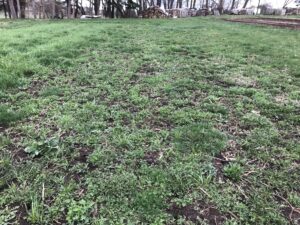
- 4/8/21 – Visual inspection of all plots showed that the clover had fared better at TO than at either BM or EQ. At EQ the clover was overtaken by weeds so completely as to no longer be able to distinguish where the aisles had been, and the plot was abandoned. At BM and TO silage plastic (6ml) was secured black side up in the broccoli occultation and mulch plots to kill both weeds and clover that had infiltrated the plots in preparation for planting.
- 4/27/21 (TO) and 4/29/21 (BM) – Occultation tarps were moved to pepper occultation and mulch plots. Broccoli was planted in a single row with 12” between plants through all treatments. One pint of compost was added to every planting hole and all seedlings were watered in after planting. Plants at BM were also covered with row cover. Plants at TO were left uncovered as is their typical practice for brassicas. A small amount of leftover clover seed was scattered in the aisles at BM to try to fill in sparse areas.
- 5/11/21 (BM) – Removed all row cover from broccoli and weeded.
- 5/24/21 (BM) and 5/25/21 (TO) – Occultation tarps were removed and peppers were planted in a single row with 18” between plants through all treatments. Every plant was given one pint of compost in the planting hole at the time of planting. The walk-behind tiller at BM broke and a borrowed tiller could not adequately work up the tilled treatment, so it was abandoned.
- 6/1/21 (BM) - Replaced many peppers killed by a late frost. Out of 51 total plants each, 50 were killed and replaced in the mulch plots, 46 in the occultation plots, and 11 in the control plots.
- 6/3/21 (TO) and 6/4/21 (BM) – Harvested all broccoli, which had all buttoned.
- 8/10/21 – 9/21/21 – Harvested green peppers weekly. Weeded planting strips and mowed living aisles as needed.
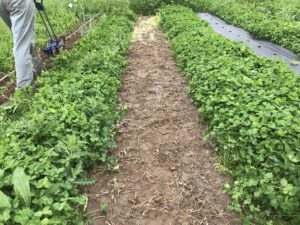
Planting method by treatment for both broccoli and peppers:
- Tilled Planting Strip: Plots were tilled with a walk-behind tiller the day before planting. A wheel hoe with a plow blade was used to make a furrow down the middle of the tilled planting strip. Compost was dropped at the appropriate spacing, followed by seedlings. Seedlings were planted by hand covering the root ball and compost with native soil.
- Occultation: Tarps were removed from the occultation treatments immediately before planting. Where weed kill was not complete, a wheel hoe with a stirrup blade was used to shallowly undercut and kill weeds. A narrow trowel was used to make planting holes at the appropriate spacing. Compost and seedlings were dropped into the holes. Seedlings were planted by hand covering the root ball and compost with native soil.
- Mulch: Where weed kill was not complete, a wheel hoe with a stirrup blade was used to shallowly undercut and kill weeds. Black woven landscape fabric with 2” diameter holes burned at the appropriate spacing was laid on the planting strip and secured along one long side with 8” sod staples. Planting holes were dug through the landscape fabric using a narrow trowel. The fabric was then pulled to one side and compost was added to each planting hole. The fabric was then pulled back over the plot and fully secured. Seedlings were dropped in the planting holes and planted by hand covering the root ball and compost with native soil through the burn hole.
- Control: Same as 1) tilled planting strip above except that the living aisles were terminated and the plots tilled with a tractor mounted rotovator one to five days before planting. Living aisles were left in place for all treatments except the control. In 2021, the control at TO was tilled with a walk-behind tractor instead of a tractor mounted rotovator.
Weed and clover densities and biomass, labor time, and vegetable yield were recorded.
Cover Crops – Living Aisles
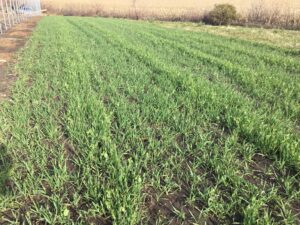
Visual assessment of the clover/oat aisles and oat/pea vegetable planting strips in October 2018 was a bit better than expected given that planting was delayed due to early September rains. Population counts for the white clover averaged from 54 (Blue Moon), to 65 (Equinox), to 69 (Two Onion) plants per square foot 14 days after seeding. These counts were less than desired based on our previous work with living aisles in 2015 and 2016. In those trials the average population density of the white clover was 120 plants per square foot.
Assessment of the clover aisles on 4/19/19 showed that all the clover at Two Onion (TO) had died over the winter and that the population densities at Equinox (EQ) and Blue Moon (BM) were not adequate to exclude weeds. The aisles at TO were reseeded at the full original seeding rates for both the clover and oats on the day of the visual inspection and filled in very nicely though the spring and summer. The aisles at EQ and BM were reseeded with only clover and at half the rate of the original fall planting, just to fill in gaps. These aisles also filled in nicely through the 2019 season.
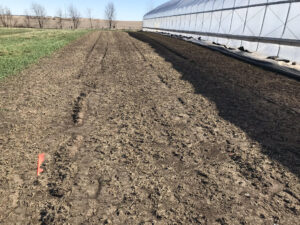
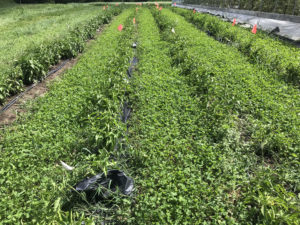
In 2020, the aisles were maintained with occasional mowing. The farmers at BM at TO reported that the clover flowered and looked pretty good overall. No other action was taken in the plots in 2020, due to the pause caused by COVID-19.
Visual assessment of the clover aisles on 4/8/21 showed that the clover was coming in pretty well at TO and that there were not many weeds apart from the field edges where quack grass was infiltrating. At BM the clover populations had diminished and weed populations had grown. At EQ the clover was overtaken by weeds so completely as to no longer be able to distinguish where the aisles had been, and the plot was abandoned.
Cover Crops – Planting Strips
Fall dry biomass of the oats and peas in 2018 was also less than desired. This winter-sensitive cover crop was planted to form an in situ mulch for two of the no-till planting strip treatments in the spring of 2019. The more biomass in the fall, the more residue that should be in place as a mulch in the spring to exclude weeds. Though we did not expect to produce enough biomass to exclude weeds for the full 2019 growing season, we did hope to at least exclude weeds through pepper planting in late May. The biomass as detailed in the numbers below, was far less than our goal of 5,000 pounds per acre, and indeed was not enough to exclude weeds through pepper planting.
Dry Biomass in lbs/acre on 10/30/18
| Farm | Oats | Peas | Total |
| Blue Moon | 391 | 328 | 719 |
| Equinox | 675 | 194 | 870 |
| Two Onion | 552 | 227 | 779 |
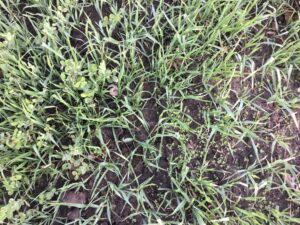
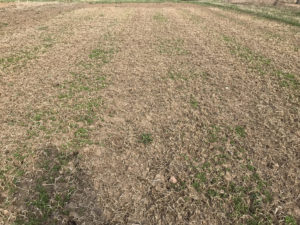
Oats and peas planted in the planting strips in fall 2019 winter killed as expected, but were not planted to vegetables or replanted to oats and peas in fall 2020, due to the pause caused by COVID-19. As a result, there were no measurements taken on the planting strip cover crops in 2020 or 2021.
Weed Control
Individual weed population counts taken 14 and 49 days after cover crop seeding in 2018 ranged from 0 to 19 weeds per square foot across the three farms and averaged 1.9 weeds per square foot. The vast majority of these weeds were annuals which did not produce seed before dying over the winter. Annual weeds were suppressed by clover and mowing in the aisles and with occultation, mulch, or tillage in the planting strips in 2019, as expected. The few perennials in the mix were more problematic and were managed by mowing the aisles and hand-pulling the planting strips.
The pause in 2020 resulted in many more annual and perennial weeds infiltrating the plots. Weed counts taken in the pepper planting strips on 6/22/21 at TO and on 6/24/22 at BM ranged from 12 to 112 weeds per square foot, with and average of 32 in the tilled treatment (TO only), 57 in the occultation treatment, 46 in the control, and 0 where the landscape fabric mulch excluded weeds in the mulched treatment (except in planting holes). More importantly, as would be expected after the pause in 2020, the perennial weeds were much more prevalent and harder to control with regular weeding. At both BM and TO quack grass came in from the edges of the overall plot. All the control plots, and one of each of the treatment plots at TO were on the edge and quack grass infiltration was so severe as to severely stunt the pepper plants in particular.
Broccoli Yield
Every broccoli plant in every treatment and control plot at every farm buttoned in 2019 and in 2021. The most likely cause of buttoning in broccoli is stress.
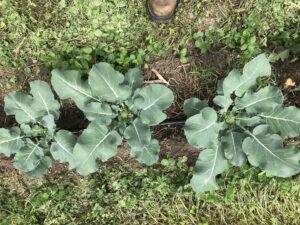
In 2019, though the seedlings looked healthy when planted, they were in their cells for about a week longer than planned, which may have caused stress. They were covered with row cover at planting to prevent flea beetle damage and preserve warmth on the cold spring nights, as is common practice at both EQ and BM, though not at TO where flea beetle pressure is less. Row cover was removed after three weeks for weeding, at which time it was already clear that all the broccoli would button.
In 2021, the seedlings were healthy when planted and did not seem at all stressed. At BM, the plants were covered with row cover immediately after planting, as in 2019. When the plants were uncovered two weeks later, they appeared wind abraded, purple, and obviously stressed. At TO, however, the plants were not covered with row cover, in accordance with their typical practice for brassicas. If the row cover had been the cause of stress, the broccoli at TO should have headed as normal. The broccoli at both BM and TO did button, however.
In both 2019 and 2021, broccoli was planted in late April. Though the weather in Wisconsin is still unsettled at that time, it is common for farms in the area to plant a first or second succession of broccoli late in the month. BM, in fact, did plant broccoli on the same day as the trial planting in 2021, and that planting did not button, though it was treated in the same way as the control in this trial. In short, there were no differences between the treatments and control in terms of broccoli buttoning, and the exact reason for the buttoning in this trial is unknown.
Yield on the buttoned broccoli was recorded both years and ranged from an average of 0 to 0.22 lbs/head. As the buttoning was the major contributor to yield, not the treatments, the data was not analyzed.
Pepper Yield
Marketable green peppers were harvested weekly, sorted into first and second quality fruits, and weighed. Non-marketable peppers were left in the field. First quality fruits were mostly blemish free, with one occasional small blemish on a large fruit. Second quality fruits were small in size or had larger healed blemishes. Non-marketable fruits were very small, diseased, or had open wounds.
In 2019, visual observation of the plots and the raw yield data both indicate that the control outperformed all three no-till treatments with living aisles. Generally it appeared that the peppers were both larger and more numerous in the control plots. Yield data for 2019 is still being analyzed. When analysis is complete, we expect it to confirm these observations.

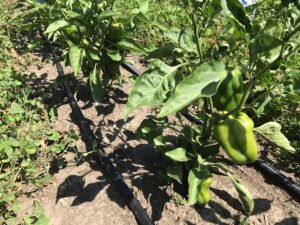
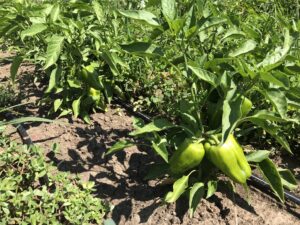
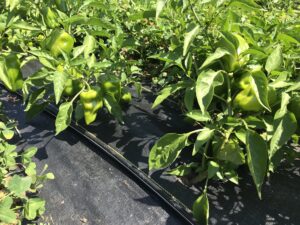
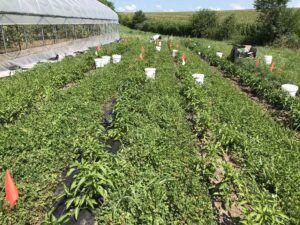
In 2021, numerous factors contributed to yield outside of the treatments. At TO quack grass infiltrated from the edges of the trial area and impacted every edge plot. Six of the 12 total pepper plots were on the edge. The three control plots, in particular, were taken over by quack grass that became impossible to terminate with hand weeding and clearly stunted the plants and reduced yield (average 0.12 lbs/plant). Even the one mulch treatment plot on the edge had enough quack root pressure to reduce the average yield by half (1.91 lbs/plant) as compared to the other two mulch plots (3.78 and 4.07 lbs/plant).
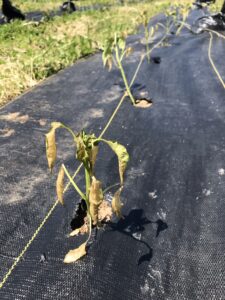
At BM in 2021, a late frost killed all but 1 plant in the mulch plots, and all but 5 plants in the occlusion plots. By comparison, 40 plants survived the frost in the control plot. The farmers speculated that more heat escaped the ground in the tilled control than in the no-till plots, thus protecting more plants in the control. Though all frosted plants were replaced from the same batch of pepper seedlings, the replacements were transplanted seven days later than the originals. This later transplant date may have contributed to a difference in their performance and by extension a difference in the performance of the mulch (average 0.59 lbs/plant) and occultation (average 0.14 lbs/plant) treatments as compared to the control (average 1.69 lbs/plant) where many fewer plants were replaced.
Because these extenuating factors made it impossible to attribute yield differences to the treatments, pepper yield from 2021 was not analyzed.
Labor Overall
Management time for each treatment was tracked in minutes for planting and maintenance (weeding, picking up mulch, etc.). Because harvest labor is primarily dependent on yield and is not affected by the treatment, it was not tracked and is not included in the labor totals. The chart below shows the total average labor in minutes for a 100’ bed by crop, treatment, and activity.
Overall Average Labor per 100' Bed in Minutes
| Broccoli | Peppers | |||||||
| Control | Tilled Strip | Occultation | Mulch | Control | Tilled Strip | Occultation | Mulch | |
| Planting | 35 | 44 | 78 | 107 | 29 | 38 | 88 | 96 |
| Maintenance | 21 | 22 | 21 | 27 | 111 | 153 | 162 | 79 |
| Total | 56 | 66 | 99 | 134 | 140 | 191 | 250 | 175 |
Broccoli Labor
Planting - The real differences in labor time show up in planting. The occultation and mulch treatments took longer to plant because individual holes had to be dug by hand into untilled soil for each individual seedling. By contract, in the control and tilled treatment, seedlings were tucked into the soft soil with minimal effort. The mulched treatment took even longer to plant because of the extra time needed to secure the mulch and finagle each seedling into the inflexible hole in the landscape fabric.
Maintenance - In the mulch treatment, weeding time was less than the other treatments or control, but the time needed to remove the landscape fabric after harvest more than made up for that savings in maintenance time overall. Given that spring broccoli is a fairly short lived crop in the field, requiring little time in weeding, the weed exclusion benefit of the mulch did not pay off in maintenance time overall.
Pepper Labor
Planting - As with broccoli, it took more time to plant peppers into the occultation and mulch treatments given the extra effort needed to dig individual seedling holes into untilled ground. Generally less planting time needed for peppers as compared to broccoli can be attributed to wider spacing between plants and thus fewer seedlings planted per 100’ bed.
Maintenance - Given the longer pepper season, there is more nuance to the maintenance time discussion, as compared to broccoli. Not surprisingly, the mulch treatment required less weeding time. Further, with the longer season and thus higher weeding requirement in the other treatments, the time invested in putting down and picking up the mulch was more than covered by time saved in weeding. More surprisingly, the time needed to mow the living aisles in the mulch treatment also was not enough to top the maintenance time in the clean cultivated control without a living aisle.
Discussion
Climate change predictions for the Midwest include more intense rain events interspersed by periods of drought. The farms in this trial experienced both conditions over the course of this project, emphasizing the need for research into methods for absorbing excess rainwater and for making it available to crops during dry periods. Because we already know that living plant material and undisturbed soil absorbs water and reduces erosion during rain events, the basic goal of this research was to test if yields could be maintained with living aisles and no-till planting methods.
Unfortunately, every broccoli plant at every farm buttoned in both years of the trail, making the broccoli yield data useless.
Further, the project was paused in 2020 due to travel and other restrictions aimed at containing COVID-19. During the pause, the trial plots were mowed, but otherwise left untouched, leaving them vulnerable to invasion by perennial weeds from the field edges. Perennial weeds are a common problem in organic no-till and reduced tillage systems and in 2021, weed pressure at EQ was so strong as to make the plot unusable for the trial. Weed pressure from the edges of the plots at TO severely compromises six of the 12 plots at that farm. Other unforeseen issues, including a late frost and broken tiller at BM, severely reduced the value of the pepper data there.
In the end, the 2019 pepper yield data was the only useful yield data. It showed that the tilled control with no living aisles outperformed the three no-till treatments. We know that competition for water and nutrients, especially during the critical weed-free period, can reduce yields in vegetable crops. Presumably, the living clover aisles presented enough competition to cause yield drag.
If there had been a savings in labor with any of the three treatments in comparison to the control, then it might have been possible to financially balance the yield drag with labor savings. But the control was also the most time efficient system.
Though this project did not show the living aisles treatments to be the same or better than the conventionally tilled control, the farmers agreed that the benefits of living aisles and reduced tillage in relation to water infiltration and reduced erosion warrant further research. In anticipation of future trial designs, this project offers the following insights:
- For a longer season crop like peppers, using landscape fabric mulch does appear to be worth the effort of application and removal in reduced weeding time, but not for a shorter season crop like spring broccoli.
- A 2- or 3-week occultation of a planting strip requires additional labor in laying down and picking up silage plastic, but does not offer a payback in longer-term weed control, especially when perennial weeds like quack grass can infiltrate from the field edge.
- A tilled planting strip requires no more time to plant than a conventionally tilled control, but does require more time to maintain through mowing of the living aisles. If yield can be equalized between the two, the additional time spent in maintenance might be worth the return in reduced erosion and increased rain water absorption.
- One consideration for equalizing yield between living aisle systems and conventionally tilled systems could be the timing and height of mowing of the clover aisles. Would mowing more frequently and shorter reduce competition with vegetable crops?
Finally, this project reinforced two of the most basic understandings in agriculture. 1) Competition from weeds or other living plants can reduce crop yields. And 2) tillage can be an effective way of controlling weeds. These understandings are part of why positive results in cover crop based no-till are so elusive in organic systems where herbicides cannot be used for cover crop termination or weed control.
Educational & Outreach Activities
Participation Summary:
The numbers above reflect the farmers and researchers involved in the trial, farmers who have requested individual consultations about no-till and/or living aisles, and farmers involved in the Climate Resilient Organic Vegetable Production community of practice that this project inspired.
A virtual field day in August 2021 highlighted this project and a partner project on living aisles and reduced tillage systems in organic vegetables.
Learning Outcomes
Project Outcomes
Though cover crops are commonly used on organic vegetable farms, using them as a base for reduced tillage techniques is still an area for experimentation. Farmers cooperating on this project are especially interested in living aisles as a way to reduce tillage, prevent erosion, and capture water during the more extreme rainfall events that are becoming common with climate change.
While this trial failed to show that yields from plots with living aisles can be maintained when compared to a conventionally tilled control, extenuating circumstances leading to a loss of usable data for broccoli in both years and for peppers in 2021, make this work far from definitive. More experimentation is required and is ongoing through one additional funded grant proposal and possibly through a second proposal being submitted by this team in 2022.
Most importantly, this project and previous work in the Midwest on organic reduced tillage techniques, has inspired a new Climate Resilient Organic Vegetable Production community of practice that started in 2020. The group meets virtually through the winters and includes farmers and researchers from the Midwest and beyond. Together we are learning from research like this, from farmers' independent experimentation, and through regular conversation.